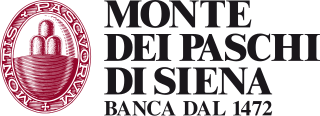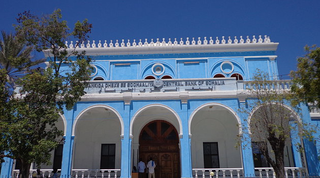
The Bank of Italy is the Italian member of the Eurosystem and has been the monetary authority for Italy from 1893 to 1998, issuing the Italian lira. Since 2014, it has also been Italy's national competent authority within European Banking Supervision. It is located in Palazzo Koch, via Nazionale, Rome.

San Marino, officially the Republic of San Marino and also known as the Most Serene Republic of San Marino, is a European microstate surrounded by Italy. Located on the northeastern side of the Apennine Mountains, it is the fifth-smallest country in the world, with a land area of just over 61 km2 and a population of 33,642, as of 2023.

The Sammarinese Communist Party was a Marxist political party in the small European republic of San Marino. It was founded in 1921 as a section of the Communist Party of Italy (PCI). The organization existed for its first two decades as an underground political organization.

Banca Monte dei Paschi di Siena S.p.A., known as BMPS or just MPS, is an Italian bank. Tracing its history to a mount of piety founded in 1472 and established in its present form in 1624, it is the world's oldest or second oldest bank, depending on the definition, and the fifth largest Italian commercial and retail bank.

The Office of Thrift Supervision (OTS) was a United States federal agency under the Department of the Treasury that chartered, supervised, and regulated all federally chartered and state-chartered savings banks and savings and loans associations. It was created in 1989 as a renamed version of the Federal Home Loan Bank Board, another federal agency. Like other U.S. federal bank regulators, it was paid by the banks it regulated. The OTS was initially seen as an aggressive regulator, but was later lax. Declining revenues and staff led the OTS to market itself to companies as a lax regulator in order to get revenue.

The Swiss National Bank is the central bank of Switzerland, responsible for the nation's monetary policy and the sole issuer of Swiss franc banknotes. The primary goal of its mandate is to ensure price stability, while taking economic developments into consideration.

UniCredit S.p.A. is an Italian multinational banking group headquartered in Milan. It is a systemically important bank and the world's 34th largest by assets. It was formed through the merger of Credito Italiano and Unicredito in 1998 but has a corporate identity stretching back to its first foundation in 1870 as Banca di Genova. UniCredit is listed on the Borsa Italiana and Frankfurt Stock Exchange and is a constituent stock of the Euro Stoxx 50 index of leading shares.

The Bank of Albania is the central bank of Albania, issuing the Albanian lek. It is headquartered in Tirana, with five branches in Shkodër, Elbasan, Gjirokastër, Korçë and Lushnjë, and a Research and Training Center in Berat.

The Central Bank of Somalia (CBS) is the monetary authority of Somalia. Somalia has struggled to reestablish a functioning state since the collapse of an authoritarian regime in 1991. Somalia has been cited as a real-world example of an anarchist stateless society and a country with no formal legal system. The Transitional Federal Government, formed in 2004, was recognized as the central government of Somalia. Among other duties, it is in charge of ensuring financial stability, maintaining the internal and external value of the local currency, and promoting credit and exchange conditions that facilitate the balanced growth of the national economy. Within the scope of its powers, it also contributes to the financial and economic policies of the State.

Intesa Sanpaolo S.p.A. is an Italian international banking group. It is Italy's largest bank by total assets and the world's 27th largest. It was formed through the merger of Banca Intesa and Sanpaolo IMI in 2007, but has a corporate identity stretching back to its first foundation as Istituto Bancario San Paolo di Torino in 1583.

State auditors are fiscal officers lodged in the executive or legislative branches of U.S. state governments who serve as external auditors, program evaluators, financial controllers, bookkeepers, or inspectors general of public funds. The office of state auditor may be a creature of the state constitution or one created by statutory law.

The following outline is provided as an overview of and topical guide to San Marino:

The Central Bank of Kosovo is the central bank of Kosovo. It was founded in June 2008, the same year Kosovo declared its independence from Serbia, with the approval of Law No. 03/L-074 on the Central Bank of the Republic of Kosovo by the Assembly of the Republic of Kosovo. Before being established as the Central Bank of Kosovo, it operated as the Central Banking Authority of Kosovo. The official currency in Kosovo is the Euro, which was unilaterally adopted by the United Nations administration for Kosovo in 2002; however, Kosovo is not a member of the Eurozone. The headquarters of the CBK are located in the capital of Kosovo, Pristina.

This page list topics related to San Marino.

Antonella Mularoni is a Sammarinese jurist and politician who served as Captain Regent of San Marino from April 2013 to October 2013, alongside Denis Amici. Mularoni was the Secretary for Foreign Affairs from 2008 to 2012 and also served as the Sammarinese judge for the European Court of Human Rights between 2001 and 2008.

Ignazio Visco is an Italian economist and central banker and Governor of the Bank of Italy from 2011 to 2023.
BPER Banca S.p.A., formerly known as Banca Popolare dell'Emilia Romagna S.C., is an Italian banking group offering traditional banking services to individuals, corporate and public entities. The company is based in Modena and is a constituent of the FTSE MIB index.
Cassa di Risparmio is the Italian word for savings bank, and may refer to:
Fondazione Cassa di Risparmio di Verona, Vicenza, Belluno e Ancona, also known as Fondazione Cariverona is an Italian banking foundation based in Verona, Veneto region. The foundation was created in 1991.

Cassa di Risparmio della Marca Trivigiana, also known as Cassamarca in short, was an Italian savings bank headquartered in Treviso, Veneto. The history of the bank goes back to 1496 when the charitable institution Monte di Pietà di Treviso was founded. The savings bank was established by the Monte in 1907, following a first bank spinoff in 1822 that ended up being absorbed in 1872 by the Cassa di Risparmio delle Provincie Lombarde.















